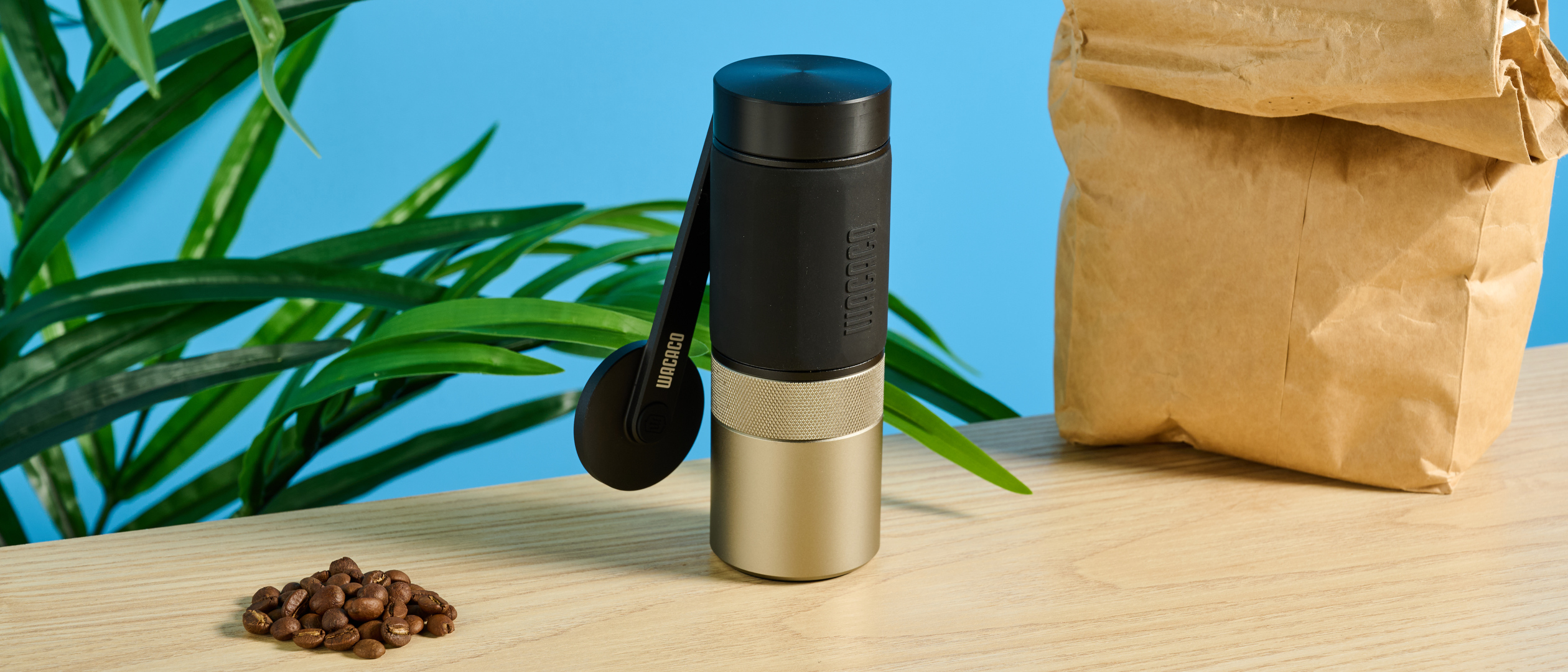Tom's Guide Verdict
The Wacaco Exagrind is a beautifully-made hand grinder capable of grinding fine enough for Turkish coffee, all the way up to medium coarse for pour over or French press. Its 38mm steel conical burrs grind fairly consistently, and it’s ideal to use with Wacaco gear, for which its grounds chamber can serve as a doser to minimize mess. It’s lightweight and compact, too, making it a great travel grinder. It can only fit 20-22g of beans, though, so those using 58mm portafilters for double espresso may need something with more space. It also produces mild static and clumping, with a 2.5% retention ratio from a full bean chamber.
Pros
- +
Beautiful design and construction
- +
Stainless steel conical burrs
- +
Consistent grind
- +
Grinds Turkish to French press
- +
Affordable(-ish)
Cons
- -
Maxes out at 20-22g
- -
Prone to static/clumping
- -
Some retention
Why you can trust Tom's Guide
The Wacaco Exagrind is a hand coffee grinder from Wacaco, who make a range of portable espresso and nespresso coffee makers. Designed primarily to accompany Wacaco’s Picopresso and Nanopresso espresso makers, the Exagrind’s 38mm stainless burrs have no problem grinding fine enough for espresso, and onwards to Turkish. It’ll also back all the way out to medium coarse, making it suitable for pour over and French press brewers. Small, lightweight and relatively consistent, this grinder is ideal for both home use and travel.
It isn’t perfect, though. Its beans chamber maxes out at 20 grams or so, which may not be enough for espresso brewers pulling double shots in 58mm portafilters, nor for +2-cup pour overs or French press. It’s also prone to a little retention, as well as static and clumping (although nothing that can’t be solved with a basic distribution tool).
However, given its relatively affordable $119 price tag, the Wacaco Exagrind’s flaws are very easy to overlook. I’ve had a great time with this charming little tool, and for me it’s one of the best coffee grinders around for the money. Find out more in my full Wacaco Exagrind review.
Wacaco Exagrind review: Price & availability
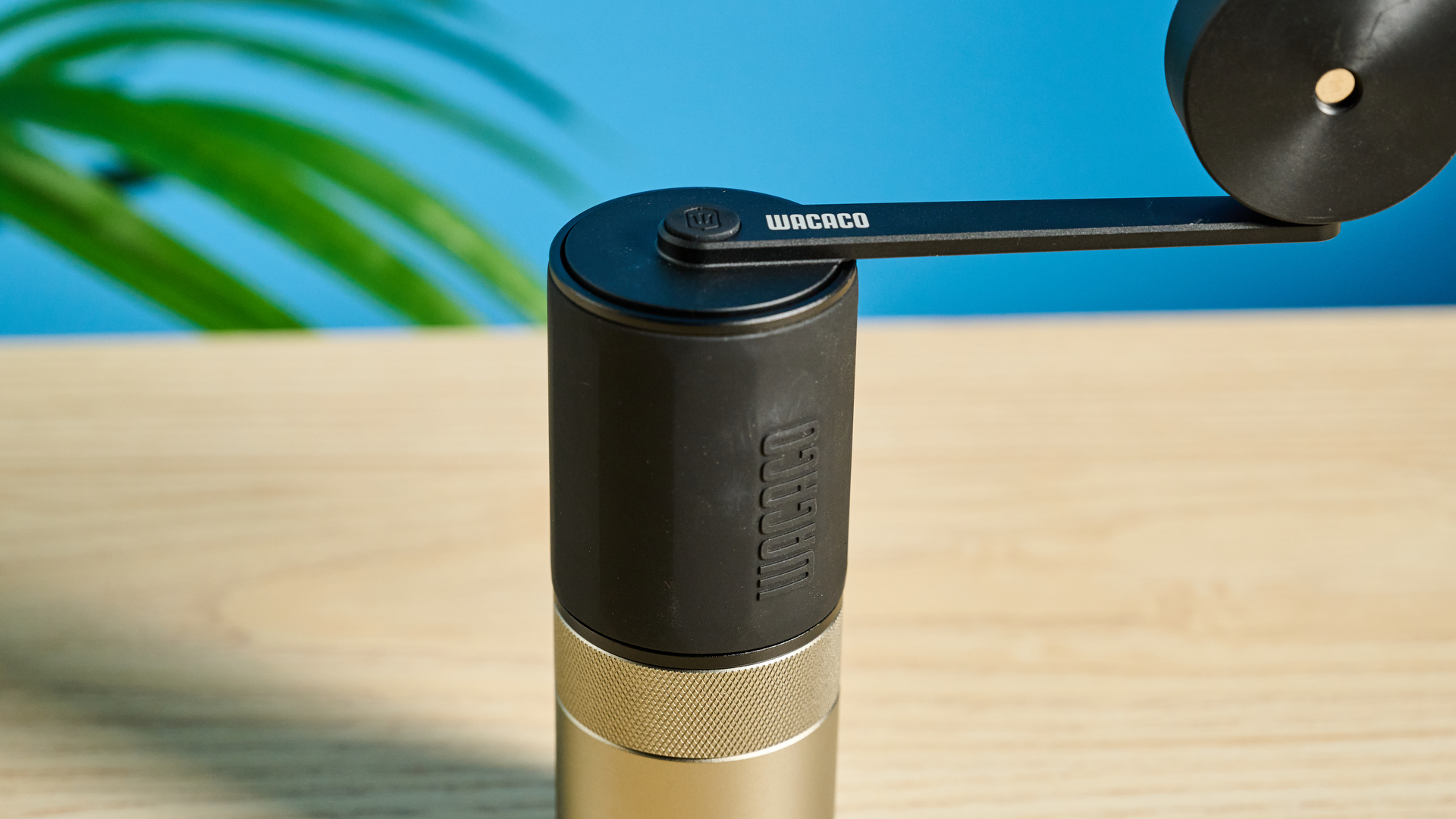
The Wacaco Exagrind costs $119 from Amazon U.S. and Wacaco direct. It’s £119 from Amazon U.K. and Wacaco direct, although Wacaco’s site lists the excluding VAT price, so £99. Unlike our American compadres, we Brits aren’t accustomed to seeing prices without taxes included, so just a little heads up to my countrymen to budget the extra £20, as the Exagrind will get pricier at checkout.
This price makes the Exagrind much cheaper than other premium stainless burr hand grinders like the Commandante C40 ($329) and 1Zpresso K-Ultra ($259), making it a relatively affordable option for espresso enthusiasts. If you’re just making pour over, though, the Hario Mini Slim ceramic burr grinder ($40) is a much better budget option.
Wacaco Exagrind review: Design
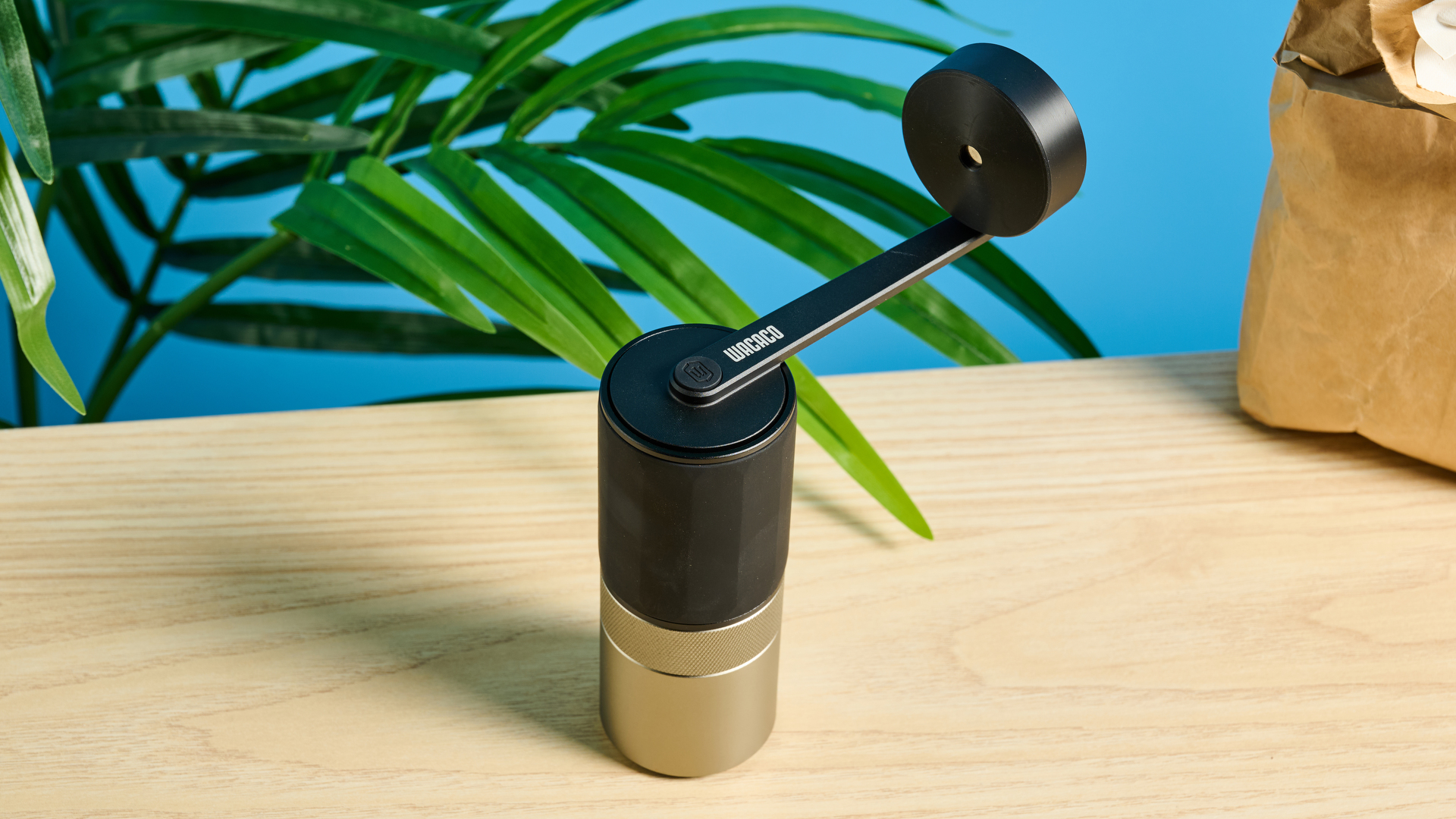
The Wacaco Exagrind boasts a premium construction, with a brushed metal grounds chamber and black metal beans chamber coated in grippy rubber. It feels beautiful and weighty in the hand, without feeling too heavy. Indeed, weighing just 1.1lbs/500g and measuring 5.6 x 2.5 inches (14.3 x 6.5cm), this is a super easy grinder to take out and about. I took it with me on a weekend trip to the countryside with friends, and it was easy to slip into my backpack. This also makes it perfect for pairing with the Wacaco Minipresso GR2, which is designed to be used as a camping/hiking coffee machine.
The bottom of the grinder features a rubber anti-slip mat, which is nice to have, although relatively pointless given you lift the grinder up when using it. As we’ll see later, though, this grinder generates a fair amount of static, so the rubber base comes in useful for tapping grounds out of the lower chamber without damaging the metal finish.
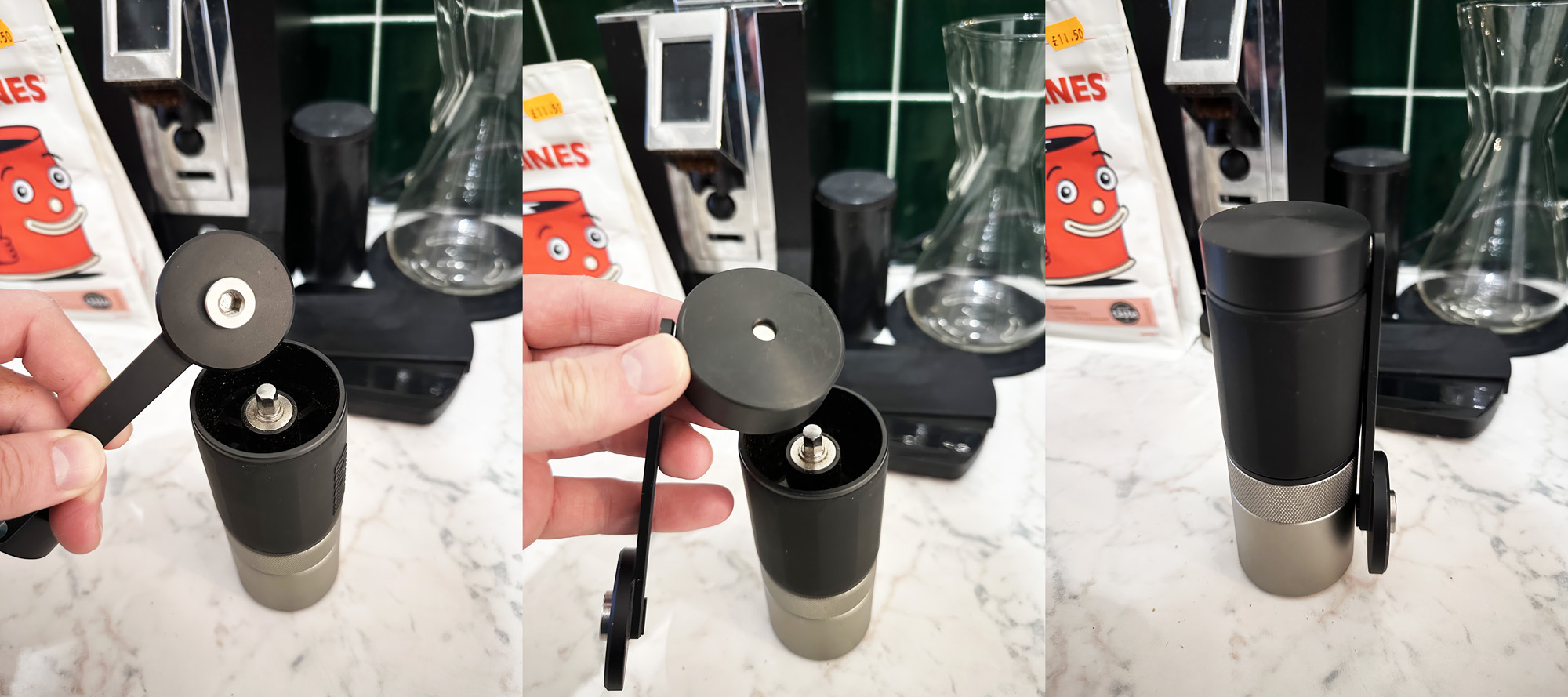
The grinder’s handle doubles up as a stowage lid when flipped. In grind configuration, one end attaches securely via a hex nut to a corresponding hex bolt on top of the crankshaft, while the other end, which articulates, is the grinder handle. Flip it 180° and the articulating handle becomes a lid for the bean chamber, with the arm and hex nut end sitting flush against the grinder body for easier stowage. This is great in theory, but is designed very poorly in practice. The articulating handle does not feature a hex nut, attaching to the top of the bean chamber via a weak magnet, which gets knocked off extremely easily inside a bag, leading to coffee in your bag and totally undermining the grinder’s otherwise fantastic portability credentials.
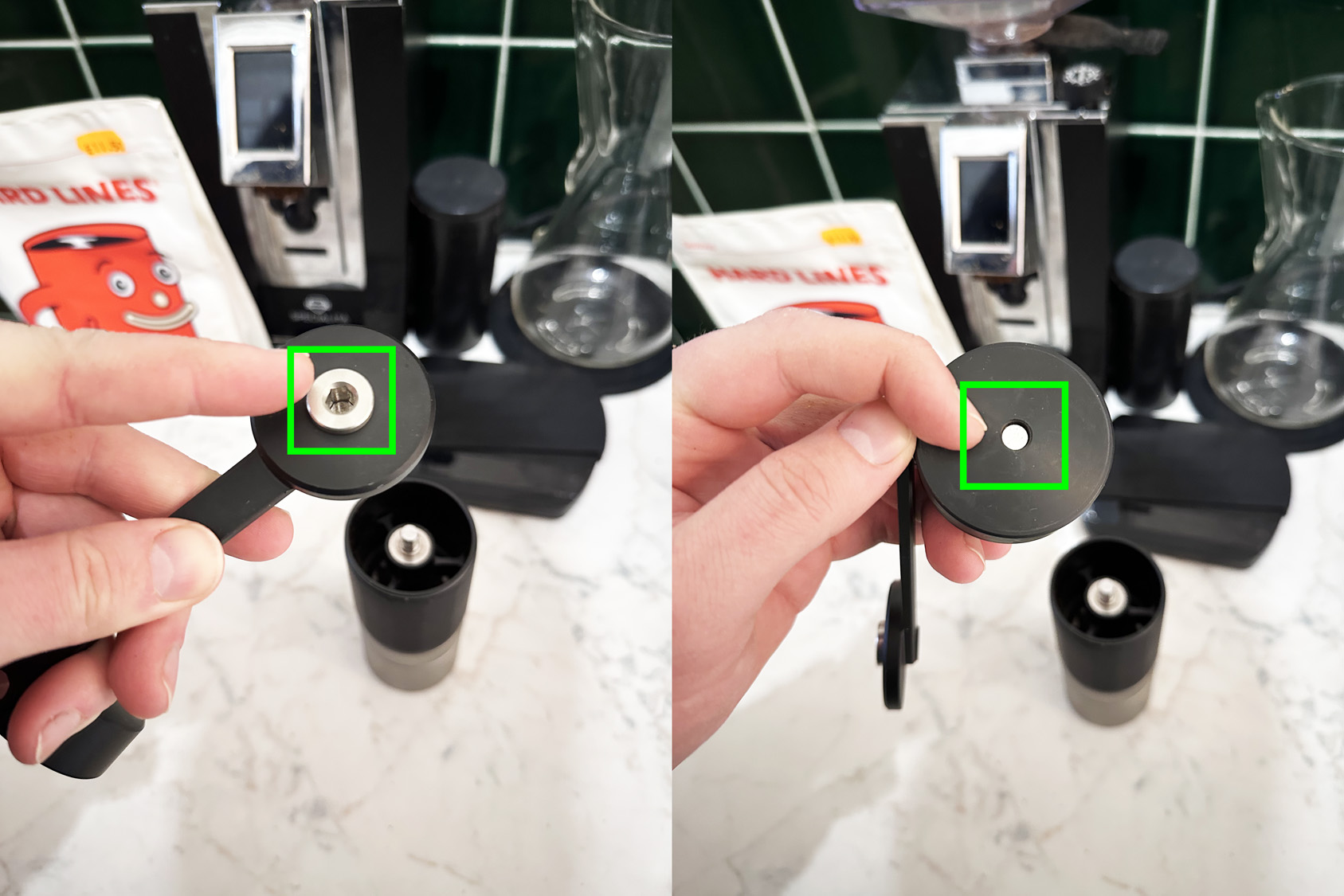
Wacaco, if you’re reading: put another hex nut, exactly the same as the one already used at one end of the handle, on the other side. It’s such a poor design. How did this pass R&D? I just leave the Exagrind in its grind configuration all of the time to prevent the lid dropping off.
Wacaco Exagrind review: Grind adjustment
The Wacaco Exagrind features a 60-click adjustment range, which is tweaked via an adjustment bar at the base of the burrs, accessible when the grounds chamber is removed.
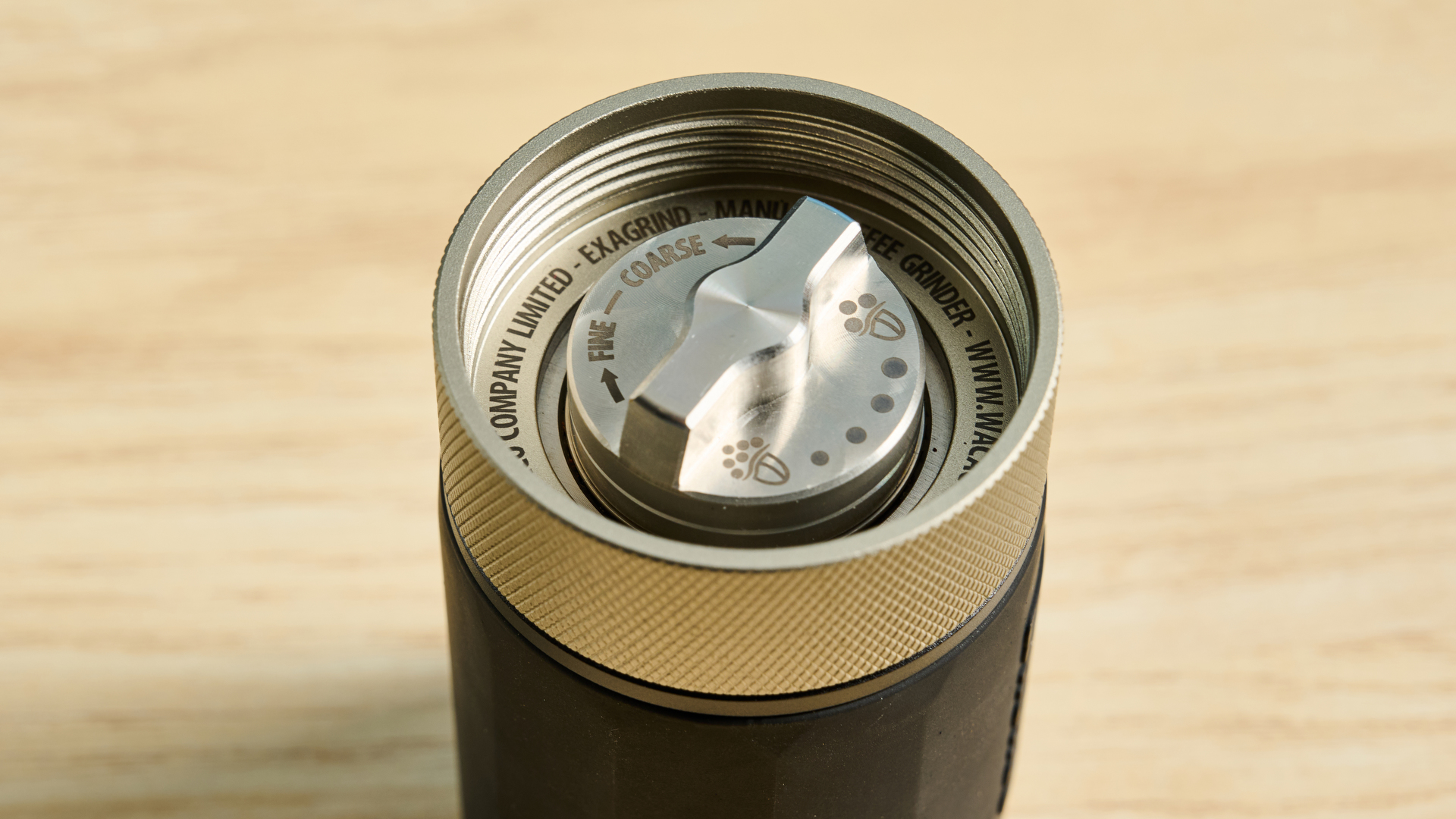
Each click represents 33μ (μ = 1/1000mm) of burr spacing, so you have a lot of fine control over your grind. There are no markers to tell you where you’re at, which is normal for hand grinders. You’ll need to count your clicks from max and min, remember where you left the burrs, and remember roughly where you need to get back to if changing brew methods.
In practice, I flit between pour over and espresso, so I found myself near the extreme ends most of the time anyway, making it relatively easy to get back and forth between the two. If brewing aeropress or drip somewhere in the middle, though, you may want to write down your click numbers to help you remember. Importantly, you mustn't use the first 6 clicks at the fine end, as this will risk the burrs touching and cause them to wear out.
Wacaco Exagrind review: Performance
The Wacaco Exagrind uses 38mm steel burrs and, as I mentioned above, gives you lots of precise control thanks to its 60-step adjustment. It’ll happily grind fine enough for Turkish coffee, and coarse enough for French press at the other end.
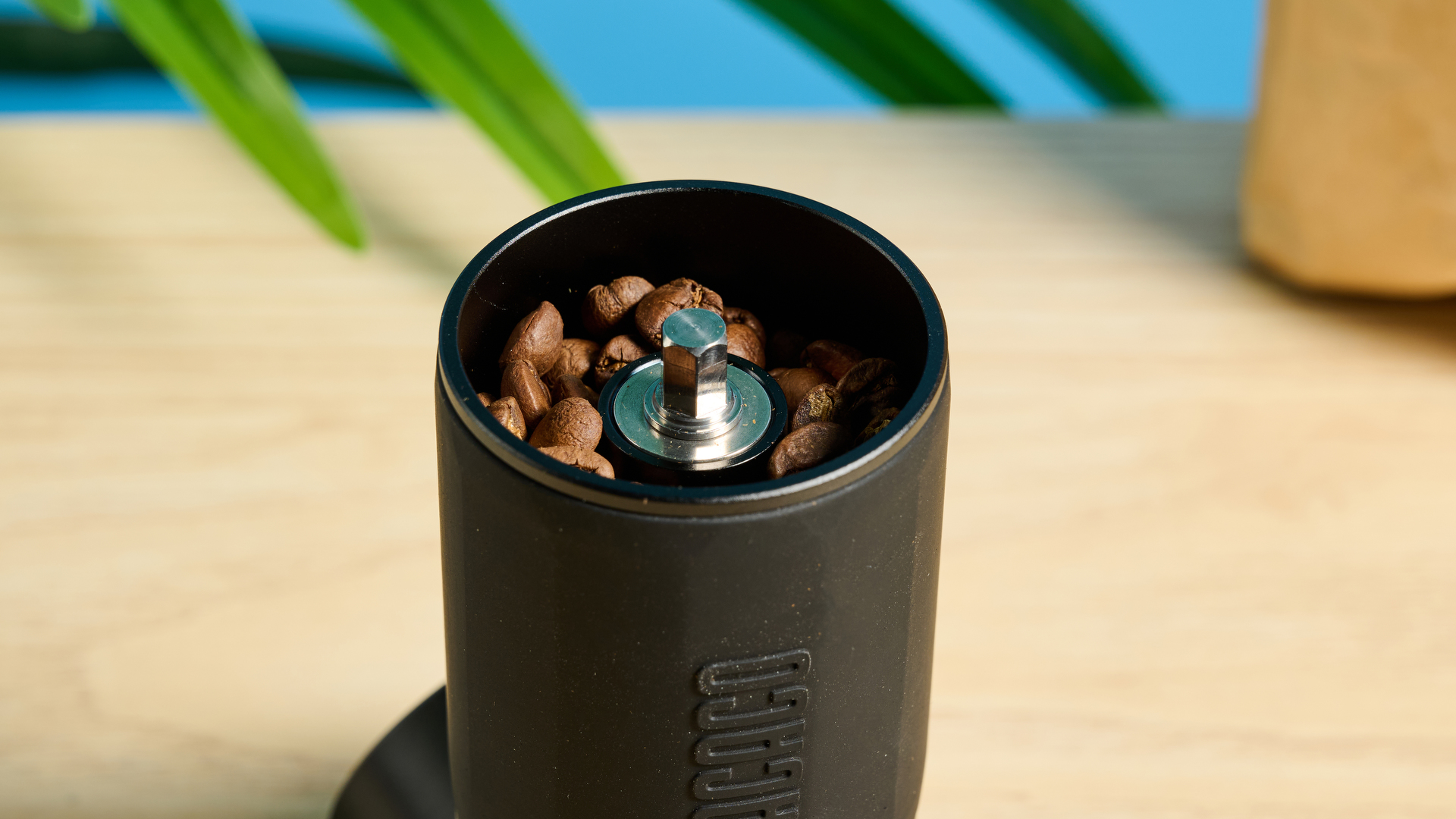
The grounds chamber is, according to Wacaco, suitable for 20g of coffee, which the brand says is enough for a double espresso. Hmm, as someone who regularly uses 58mm portafilters for 24g dose double espresso shots, I’d disagree there. The argument also runs counter to our testing on the Wacaco Picopresso, which after extensive testing we found produces its best results from 21-22g of coffee. All that said, you can get 22g of beans into the grinder at a push, and once you start grinding you can add more. If you’re after making a large batch of French press or a 6-cup Chemex, though, I’d invest in a grinder with a bigger chamber, such as the Hario Skerton Plus ($44).
With its stainless burrs, the Wacaco Exagrind is an extremely smooth grinder, and very satisfying to use. It’s also a relatively quick grinder, taking just over a minute to grind 22g of coffee to espresso consistency during testing. That was going at full pelt, though, and was quite the work out. I also tested out 20g at Turkish consistency, which was extremely hard work, and took me several minutes. And of course, I tested at both Aeropress and pour over grinds, which were much quicker than espresso, requiring a lot less energy.
Static & clumping
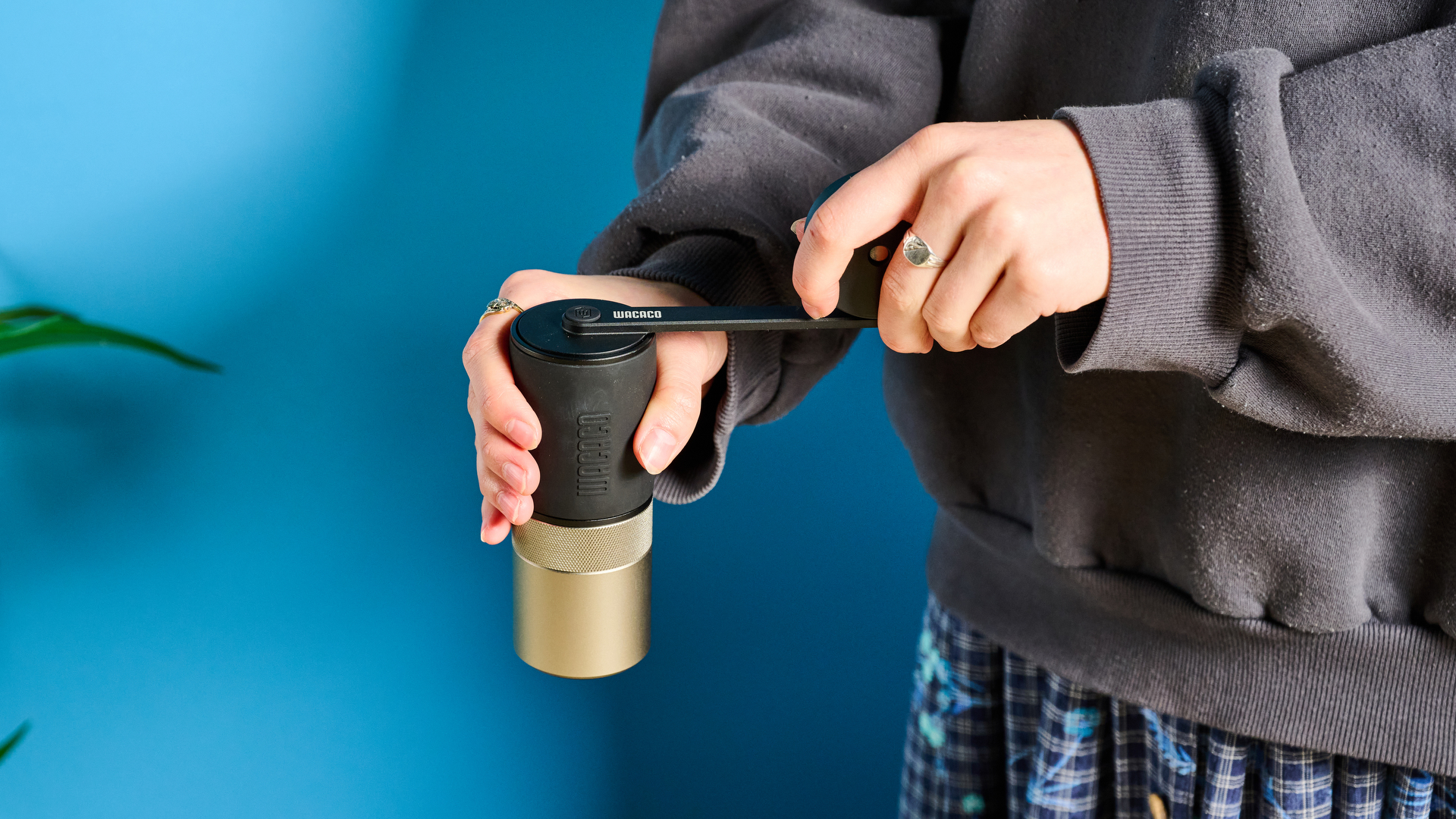
Get your paper clips ready, ‘cause the Exagrind is a clumper, well, at espresso consistencies anyway. Nothing serious, so you’ll be fine with a basic WDT (Weiss Distribution Technique: A.K.A, swirl a paper clip around your grinds for a bit). What is more problematic, though, is that the same static causing the clumping also causes grounds to get stuck inside the lower chamber. This resulted in me having to knock the chamber like a nearly-empty ketchup bottle every time. I realized I was damaging the metal exterior by doing this, but thankfully realized I could knock on the rubberized base before any serious damage was done.
Consistency
The Exagrind is a relatively consistent grinder. I put 10g of coffee through the grinder, setting it to a medium fine (veering fine) grind for Aeropress (I was actually using the Wacaco Minipresso GR2, which we found works best at an Aeropress-level grind). I then put the grounds through our Kruve coffee sieve to separate the grind sizes, using the Kruve brew guide as a reference chart. As you can see, the overwhelming bulk of the grounds were caught by the 500μm sieve, then the 300μm sieve, representing medium fine/fine — bueno. There were also some <300μm grounds, and quite a few grounds caught by the 800μm sieve — not so bueno. That said, there were relatively few grounds caught by the 1100μm and 1400μm sieves, which was reassuring to see.
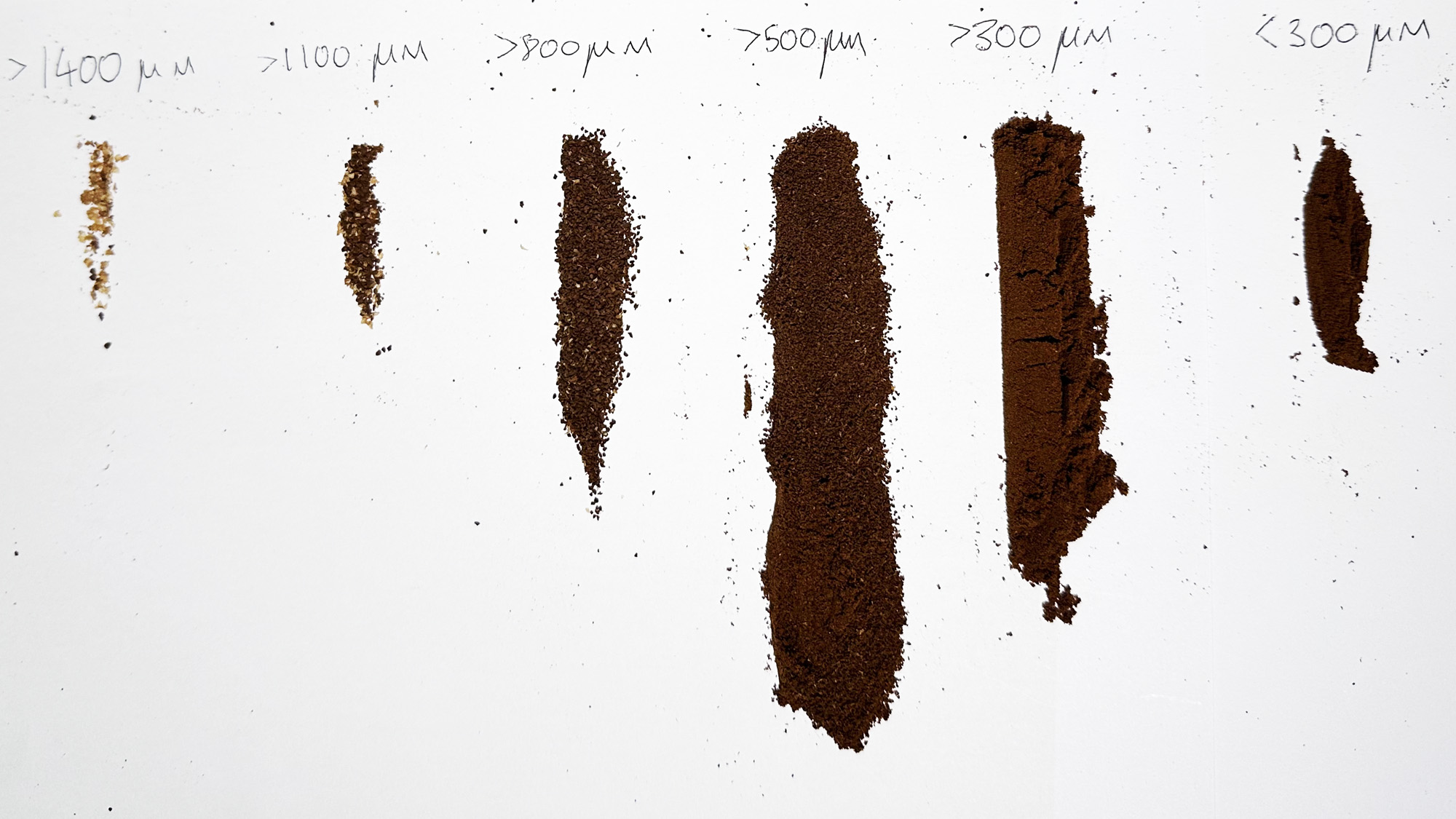
Of course, those numbers don’t lie. But nor do they tell the full story. While the Exagrind isn’t the neatest grinder out there, it made absolutely fine ground coffee for everything I threw at it, time and time again. I tested the grinder for French press, Chemex, V60, Aeropress, Espresso and Turkish, and got delicious drinks for all of the above.
Retention
The Wacaco Exagrind also suffers from some retention in its burrs and upper chamber. Nothing major, but in testing, using my Felicita Arc coffee scale, 0.5g of a 20g dose of beans were retained, equating to 2.5%. This is minimal, but that amount can make a difference to how an espresso shot pulls, so it’s worth mentioning — that’s why we coffee geeks demand scales that measure to 0.1g, after all. You can knock the retention down to around 0.1 to 0.2g using the aforementioned ketchup bottle method.
Wacaco Exagrind review: Extra features
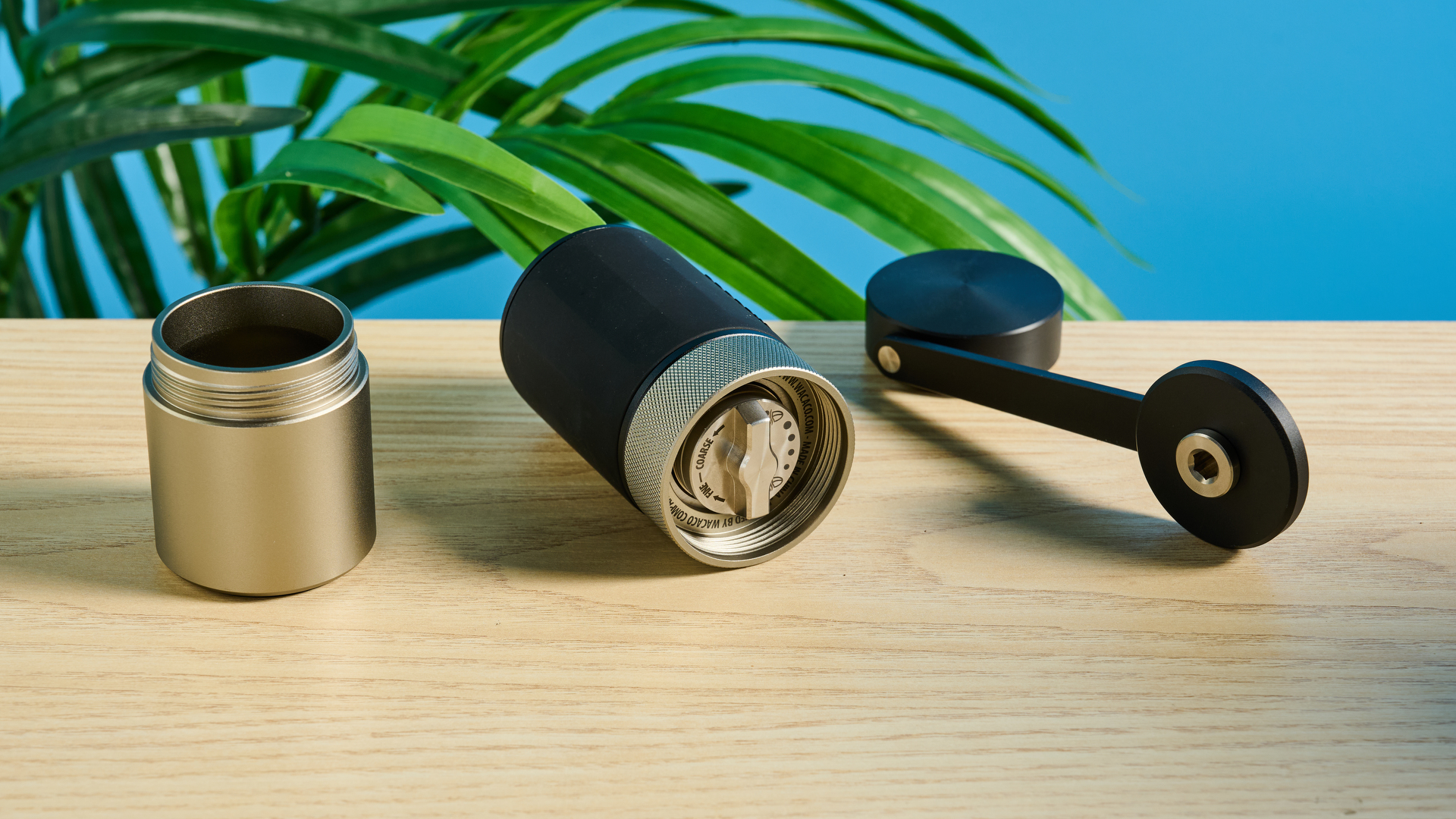
Despite Wacaco touting the Exagrind as being best suited to its Picopresso coffee maker, I found the Exagrind best suited to the Nanopresso. Don’t get me wrong, this grind isn’t unsuited to any espresso maker, unless you need more than 22g of grounds, so it works fine with the Picopresso. However, the Exagrind’s grounds chamber is the exact same diameter as the portafilter on the Wacaco Nanopresso, which means you can use the metal chamber as a dosing funnel to avoid messy grounds spills.
This was a satisfying demonstration of attention to detail on Wacaco’s part, assuming of course that this was deliberate. The grounds chamber is much smaller in circumference than the Picopresso’s 18g espresso basket, but that coffee maker comes with a dosing funnel to cut down on mess anyway.
Wacaco Exagrind review: Storage & maintenance
As I mentioned in the design section, the Wacaco Exagrind features a reversible grind handle that, when reversed, sits flush against the grinder’s body. This makes the grinder much more portable and easy to store than when in its grind configuration. When reversed, though, the lid is infuriatingly easy to knock off and can cause a mess in your bag if travelling, but I’ve already covered that so I’ll leave it there.
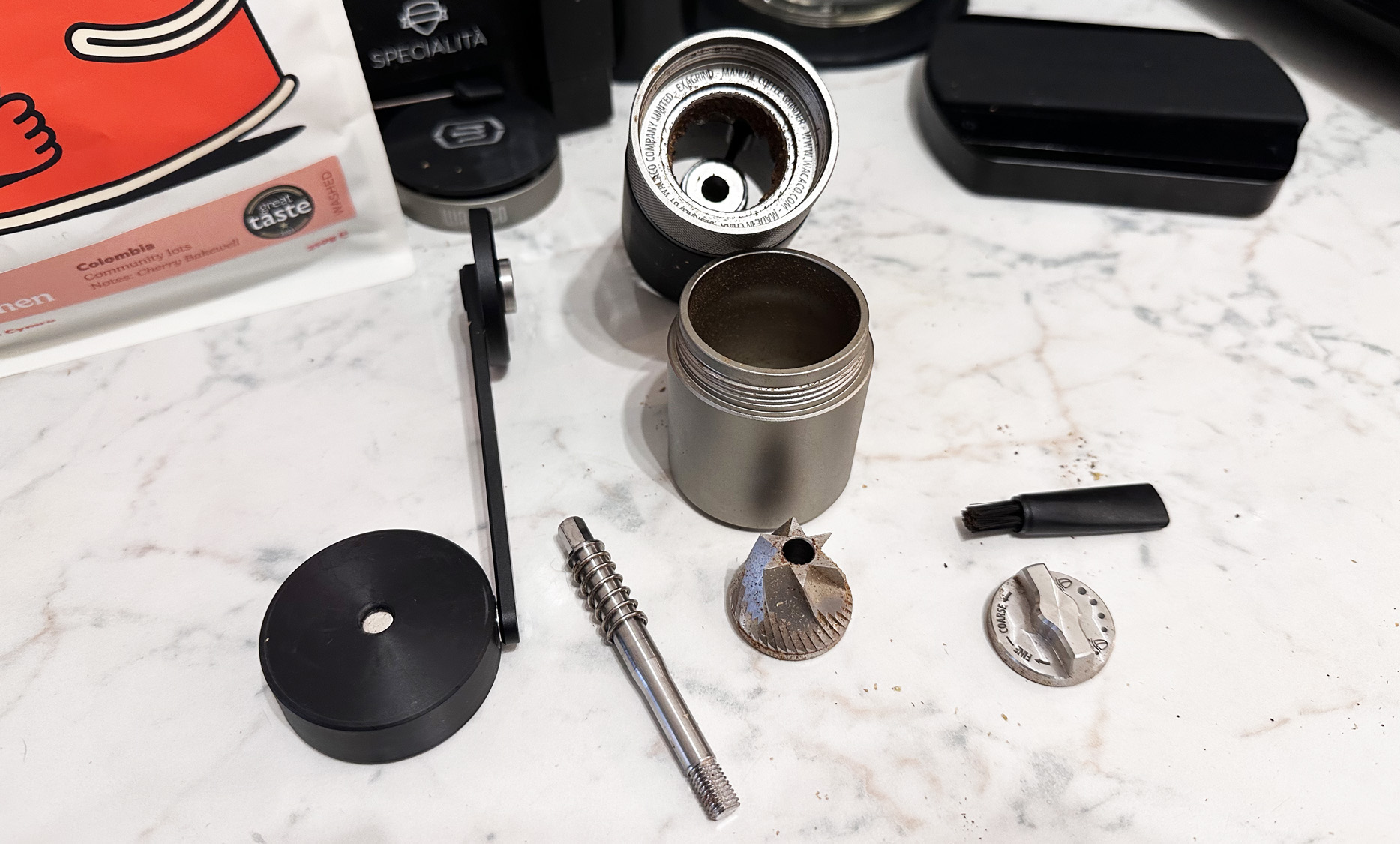
Otherwise, thanks to its generally thin profile, the Exagrind is incredibly easy to pack away into a right cupboard or to nestle amongst a compact coffee station, like mine.
Cleaning is a doddle. Simply unscrew the lower chamber, secure the crankshaft in place with the grind handle, back the burr adjustment out towards coarse until the central burr pops out, dust away grounds with the provided brush, and then reassemble.
Wacaco Exagrind review: Verdict
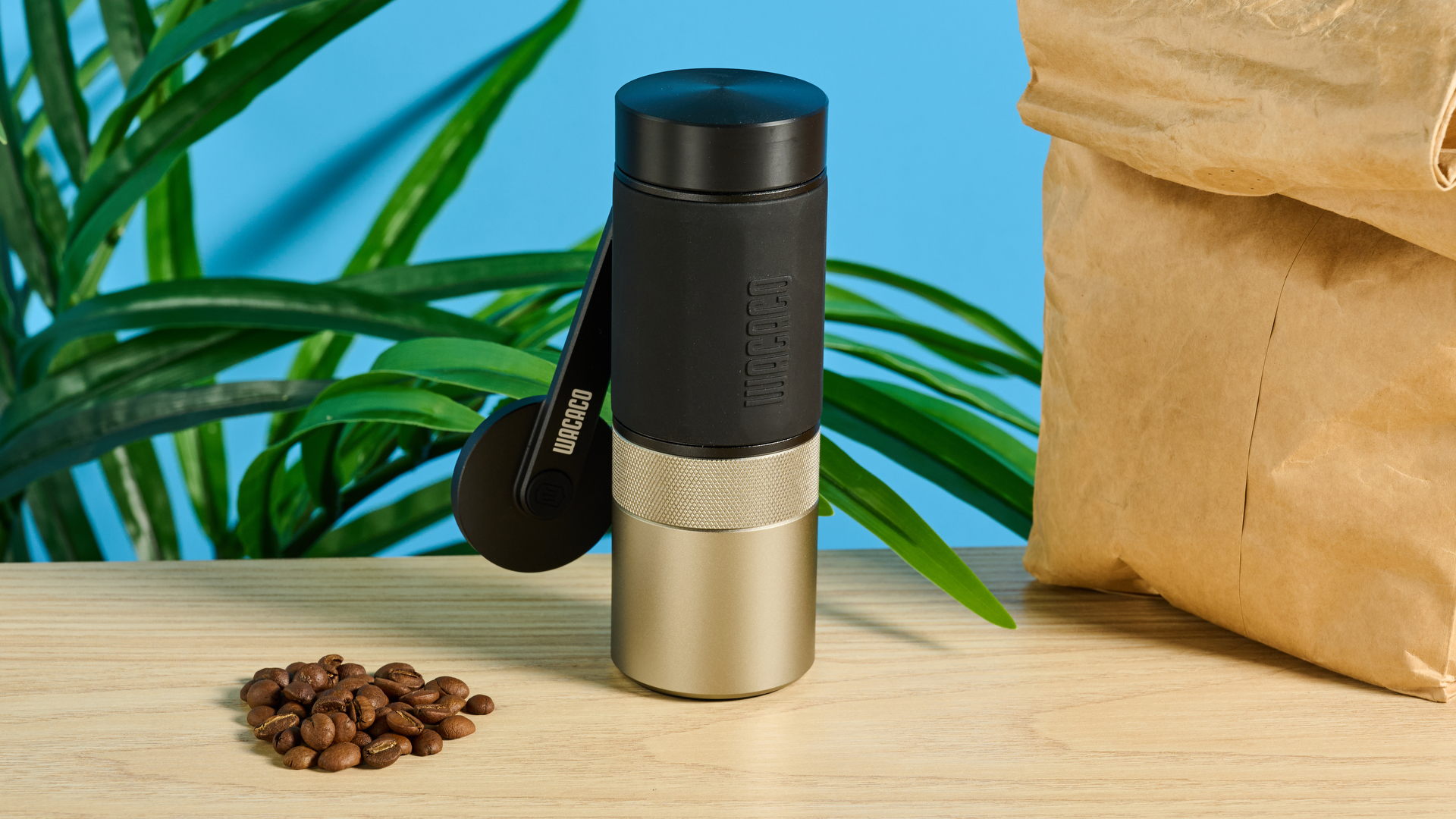
The Wacaco Exagrind isn’t perfect, but it’s as good as it needs to be for the price. This grinder features 38mm stainless steel burrs which provide fairly consistent results, making it a suitable grinder for up-and-coming coffee nerds. With its wide 60-click adjustment range, it can handle anything from French press to Turkish, so it’s a solid grinder for espresso enthusiasts. It’s built beautifully and relatively affordable versus premium competition like the Commandante C40 and 1Zpresso K-Ultra. For those brewing on the go, it’s lightweight and portable, and if you’re using a Wacaco espresso maker, especially the Nanopresso, the Exagrind should be top on your list of companion accessories.
The Exagrind isn’t the be-all end-all of consistent grinding, there’s no doubt about that, and it suffers from a little static/clumping, plus a small but noticeable amount of retention. Its handle’s stowage mode is also a missed opportunity, snatching defeat from the jaws of victory and proving more frustrating than useful, especially when travelling. Does any of this stop it grinding coffee well enough to make fantastic-tasting drinks, though? Not one bit. The Exagrind is staying at my coffee station for the time being, that’s for sure.

Peter is Reviews Editor at Tom's Guide. As a writer, he covers topics including tech, photography, gaming, hardware, motoring and food & drink. Outside of work, he's an avid photographer, specialising in architectural and portrait photography. When he's not snapping away on his beloved Fujifilm camera, he can usually be found telling everyone about his greyhounds, riding his motorcycle, squeezing as many FPS as possible out of PC games, and perfecting his espresso shots.
You must confirm your public display name before commenting
Please logout and then login again, you will then be prompted to enter your display name.
